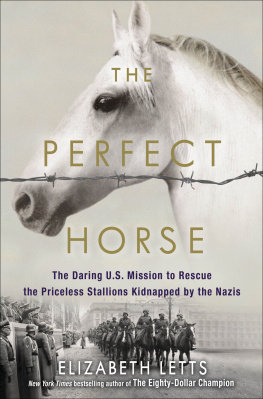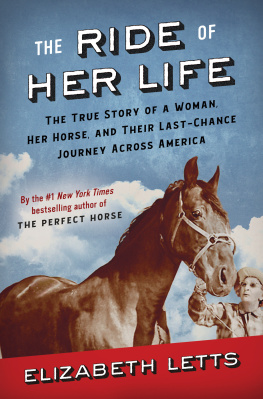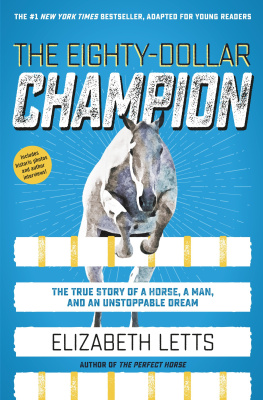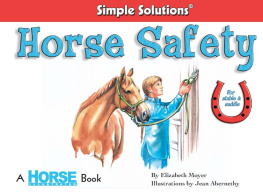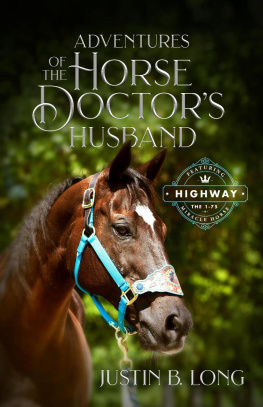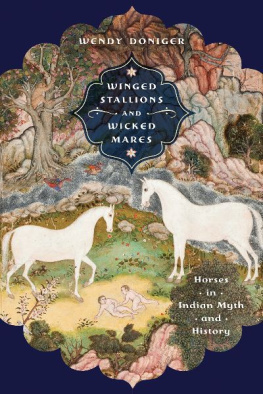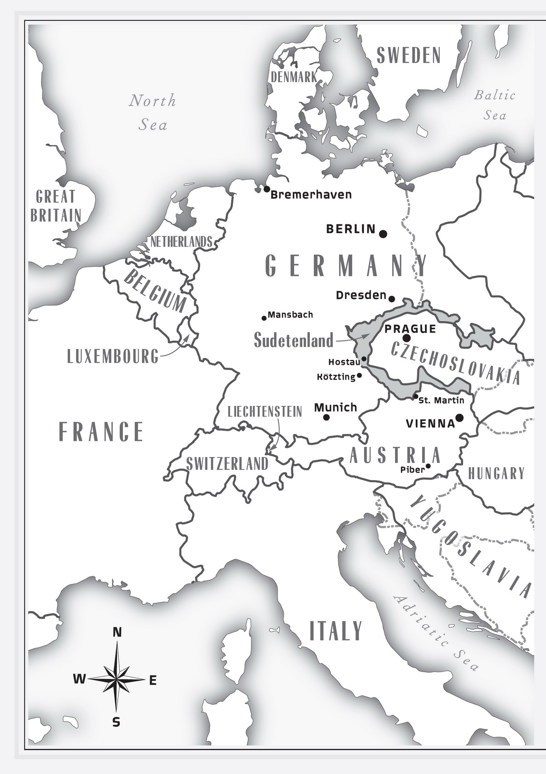As of the time of initial publication, the URLs displayed in this book link or refer to existing websites on the Internet. Penguin Random House LLC is not responsible for, and should not be deemed to endorse or recommend, any website other than its own or any content available on the Internet (including without limitation at any website, blog page, information page) that is not created by Penguin Random House.
Copyright 2016 by Elizabeth Letts
Map copyright 2016 by Mapping Specialists, Ltd., Madison, Wisconsin
All rights reserved.
Published in the United States by Ballantine Books, an imprint of Random House, a division of Penguin Random House LLC, New York.
B ALLANTINE and the H OUSE colophon are registered trademarks of Penguin Random House LLC.
L IBRARY OF C ONGRESS C ATALOGING - IN -P UBLICATION D ATA
N AMES: Letts, Elizabeth, author.
T ITLE: The perfect horse: the daring U.S. mission to rescue the priceless stallions kidnapped by the Nazis / Elizabeth Letts.
D ESCRIPTION: First edition. | New York: Ballantine Books, [2016] | Includes bibliographical references and index. | Description based on print version record and CIP data provided by publisher; resource not viewed.
I DENTIFIERS: LCCN 2016030226 (print) | LCCN 2016010501 (ebook) |
ISBN 9780345544810 (paperback) | ISBN 9780345544803 (hardcover: alk. paper)
S UBJECTS: LCSH: World War, 19391945Confiscations and contributionsUnited States. | World War, 19391945Commando operationsCzech RepublicHostou. | Lipizzaner horseAustriaHistory20th century. | Arabian horsePolandHistory20th century. | World War, 19391945Confiscations and contributionsGermany. | Spanische Reitschule (Vienna, Austria)History20th century. | Podhajsky, Alois. | World War, 19391945Austria. | Reed, Charles Hancock, 19001980. | United States. Army. Cavalry Regiment, Mechanized, 2ndHistory.
C LASSIFICATION: LCC D810.C8 (print) | LCC D810.C8 L46 2016 (ebook) |
DDC 940.54/213714dc23
LC record available at https://lccn.loc.gov/2016030226
Ebook ISBN9780345544810
randomhousebooks.com
Title-page photo: Associated Press
Book design by Barbara M. Bachman, adapted for ebook
Cover design: Marietta Anastassatos
Cover image of military scene: ullstein bild/Getty Images
v4.1
a
COURAGE IS BEING
SCARED TO DEATHAND
SADDLING UP ANYWAY .
John Wayne
CONTENTS
LIST OF CHARACTERS
T HE E UROPEANS
Andrzej Kristalovich (Andrzej Krzysztalowicz): /Ahn-jay Kshee-stal-o-veech/ Director of Polands national stud farm.
Rudolf Lessing: German army veterinarian stationed at the Hostau stud farm in Czechoslovakia.
Alois Podhajsky: /Ah-loys Pod-hey-skee/ Austrian director of the Spanish Riding School of Vienna.
Gustav Rau: German horse expert. Chief equerry in charge of all horse breeding in the Third Reich.
Hubert Rudofsky: Czech-born ethnic German. Director of the stud farm in Hostau, Czechoslovakia.
Jan Ziniewicz: /Yahn Zee-nee-ev-eech/ Chief groom of Polands National Stud Farm.
T HE A MERICANS
Major James Pitman: West Point graduate, lover of dogs and horses. Executive officer of the 42nd Squadron of the 2nd Cavalry.
Lieutenant William Donald Quin Quinlivan: Career cavalryman. Assigned to the 42nd Squadron of the 2nd Cavalry.
Colonel Charles Hancock Hank Reed: Virginia-born, expert horseman, commanding officer of the 2nd Cavalry.
Captain Ferdinand Sperl: Swiss-born naturalized U.S. citizen. Interrogator attached to the 2nd Cavalry.
Captain Thomas Stewart: Son of a Tennessee senator. Intelligence officer in the 2nd Cavalry.
T HE H ORSES
Lotnik: Gray Arabian stallion foaled in Poland.
Neapolitano Africa: Austrian Lipizzaner performing stallion, one of Alois Podhajskys personal mounts.
Pluto Theodorosta: Austrian Lipizzaner performing stallion, one of Alois Podhajskys personal mounts.
Witez: /Vee-tezh/ Bay Arabian stallion foaled in Poland in 1938. His official registered name was Witez II.
PROLOGUE
BOMBARDMENT
VIENNA, AUSTRIA ,
SEPTEMBER 10, 1944
A shrill air raid signal pierced the quiet of the cobblestoned Michaelerplatz, a plaza in the heart of central Vienna. A moment later, the grand baroque edifices ringing the square shuddered in violent reverberation. Vienna was under siege. On the grounds of the Hofburg Palace, tucked away from view in the ornate stables that once belonged to an emperor, thirty-three majestic white stallions startled, pawing and rearing, their eyes white-rimmed with fear.
Peering out of a box stall, one eight-year-old Lipizzaner stood perfectly still, his white coat glowing in the stables dim light. His ears pricked forward as he tried to pick out the soft tread of his masters footsteps through the sound of airplanes roaring overhead. Next to his stall, on a small black slate, his name, Neapolitano Africa, and his birthdate, 1935, were neatly stenciled in white paint. A moment later, a slim middle-aged gentleman rushed to Africas side, whispering a word of reassurance, then placing a warm hand on the stallions shoulder. Alois Podhajsky was utterly concentrated on a single goalto keep his stallions safe. With a deft motion, Podhajsky slipped the polished leather halter from its peg next to the stall. The stallion lowered his head and placed his speckled muzzle through the leather noseband, helping to make the task easier. His eyes seemed to say, I know whats going on here. Let me help.
By now the entire stable, with its marble water basins and neatly hung tack, its wide aisles and airy stalls, was a hive of activity: Grooms in gray uniforms quickly haltered some of the stallions while riders, in their buckskin britches and jackets, took charge of others. Around them, bits of plaster broke free and a powdery residue sifted down like snow.
In single file, the horses and men crossed a large courtyard, passed through heavy iron-studded wooden doors, and then clattered across a city street, now deserted. The horses filed through a second set of doors and into a sheltered hallway. The stallions had calmed and didnt shy or balk even as the loud booms and crashes almost drowned out the ringing of their iron shoes on the cobblestones. The last to enter the shelter of the hallway was Alois Podhajsky, Olympic bronze medal winner and director of the Spanish Riding School of Vienna. The enormous wooden doors swung shut behind them; here, the thick walls muffled the sounds a little bit. For the first moment since hearing the air raid signal, Podhajsky took a deep breath. He reached into the leather pouch at his hip, extracted a sugar lump, and offered it to Africa, feeling the tickle of the horses whiskers as he lipped it up from Podhajskys bare palm. Horse and man were clearly intimate and seemed to converse without words, the man promising protection and the horse evidently comforted by his silent reassurance.

